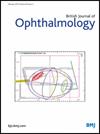Correlation between quantitative OCT metrics and contrast sensitivity function in retinal artery occlusion.
IF 3.5
2区 医学
Q1 OPHTHALMOLOGY
引用次数: 0
Abstract
AIMS To investigate the association between optical coherence tomography (OCT) biomarkers and contrast sensitivity (CS) measured by the quantitative contrast sensitivity function (qCSF) in retinal artery occlusion (RAO). METHODS This cross-sectional study included RAO patients and age-matched controls undergoing visual acuity (VA), qCSF testing and spectral-domain OCT. Only eyes with VA≥20/200 were included for reliable CS evaluation. OCT quantified retinal layer thickness, ischaemic lesion size and distance from ischaemia to the fovea. Linear regression analyses were performed. RESULTS 27 RAO eyes (17 branch RAO (BRAO), 63%) and 48 control eyes were included. All qCSF metrics were significantly reduced in RAO and central RAO compared with controls (p≤0.012). In BRAO, AULCSF and low spatial frequency CS (1-6 cycles per degree (CPD)) were significantly lower than controls (p≤0.011), whereas VA showed no significant difference. Univariable regression analysis revealed inner nuclear layer (INL) thickness (0-3 mm) was significantly associated with VA and all qCSF parameters (p<0.05). Larger ischaemic areas and closer foveal proximity correlated with worse AULCSF, contrast acuity and high spatial frequency CS (6-18 CPD; p<0.05), but not VA. Multivariable regression confirmed INL (0-3 mm) thickness was associated with VA and CS at 3 and 6 CPD (p<0.05), and foveal proximity with CS at 18 CPD (p=0.045). CONCLUSIONS qCSF shows strong correlations with INL thickness and ischaemia metrics in RAO eyes, supporting it as a valuable complementary functional measure to VA, and a meaningful clinical endpoint in RAO evaluation, particularly in foveal-sparing cases.定量OCT指标与视网膜动脉闭塞对比敏感度功能的相关性。
目的探讨光学相干断层扫描(OCT)生物标志物与定量对比敏感度函数(qCSF)测量的视网膜动脉闭塞(RAO)的对比敏感度(CS)之间的关系。方法本横断面研究纳入了RAO患者和年龄匹配的对照组,分别进行了视力(VA)、qCSF测试和光谱域oct检测,仅纳入VA≥20/200的眼睛进行可靠的CS评估。OCT量化视网膜层厚度、缺血病变大小和缺血到中央凹的距离。进行线性回归分析。结果共纳入RAO眼27只(BRAO分支17只,占63%),对照眼48只。与对照组相比,RAO组和中央RAO组的所有qCSF指标均显著降低(p≤0.012)。在BRAO中,AULCSF和低空间频率CS(1 ~ 6个周期/度(CPD))显著低于对照组(p≤0.011),而VA无显著差异。单变量回归分析显示,内核层(INL)厚度(0 ~ 3 mm)与VA及qCSF各参数均有显著相关性(p<0.05)。多变量回归证实,INL (0-3 mm)厚度与3和6 CPD时的VA和CS相关(p<0.05),与18 CPD时的CS相关(p=0.045)。结论:sqcsf与RAO眼内l厚度和缺血指标有很强的相关性,支持其作为VA的有价值的补充功能指标,是RAO评估的有意义的临床指标,特别是在保留中央凹的病例中。
本文章由计算机程序翻译,如有差异,请以英文原文为准。
求助全文
约1分钟内获得全文
求助全文
来源期刊
CiteScore
10.30
自引率
2.40%
发文量
213
审稿时长
3-6 weeks
期刊介绍:
The British Journal of Ophthalmology (BJO) is an international peer-reviewed journal for ophthalmologists and visual science specialists. BJO publishes clinical investigations, clinical observations, and clinically relevant laboratory investigations related to ophthalmology. It also provides major reviews and also publishes manuscripts covering regional issues in a global context.

 求助内容:
求助内容: 应助结果提醒方式:
应助结果提醒方式:


